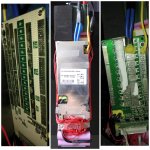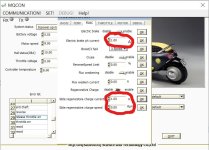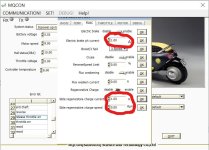Sparfuchs
1 kW
- Joined
- Nov 22, 2020
- Messages
- 305
Hello EV friends,
unfortunately i haven't found enough information about regenerative charge to be sure i wouldn't harm my battery or my controller (if this is even possible ?). I've a Sabvoton 72150 with a Mxus 3k turbo and a 20s6p battery pack with samsung 35e cells, charge current is 5A. For more details here is the battery pack link:
https://www.aliexpress.com/item/32954363991.html?spm=a2g0s.9042311.0.0.27424c4dAYzvKr
I'd like to use a thumb throttle to use the variable braking funktion.
So i would really appreciate if someone could tell me what range is safe to use, or most common/effective, or what range to try out with my set up at following settings in the sabvoton software:
Slide regenerative charge current (A) ?
Slide regenerative charge speed (rpm) ?
Thanks a lot for your help.
Best regards Sparfuchs
unfortunately i haven't found enough information about regenerative charge to be sure i wouldn't harm my battery or my controller (if this is even possible ?). I've a Sabvoton 72150 with a Mxus 3k turbo and a 20s6p battery pack with samsung 35e cells, charge current is 5A. For more details here is the battery pack link:
https://www.aliexpress.com/item/32954363991.html?spm=a2g0s.9042311.0.0.27424c4dAYzvKr
I'd like to use a thumb throttle to use the variable braking funktion.
So i would really appreciate if someone could tell me what range is safe to use, or most common/effective, or what range to try out with my set up at following settings in the sabvoton software:
Slide regenerative charge current (A) ?
Slide regenerative charge speed (rpm) ?
Thanks a lot for your help.
Best regards Sparfuchs




